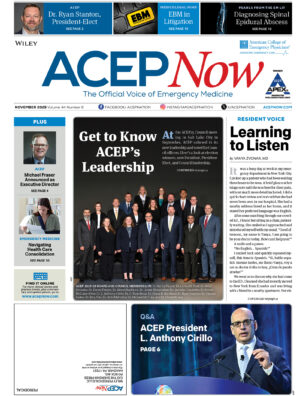Attendees were treated to an irreverent and timely review of 15 studies published in the last year. W. Richard Bukata, MD, clinical professor emergency medicine at the Los Angeles County/University of Southern California, and Jerome R. Hoffman, MD, FACEP, professor of medicine emeritus at UCLA School of Medicine in Los Angeles, led the interactive discussion that covered a range of topics.
Explore This Issue
ACEP16 Tuesday Daily NewsThe first five studies focused on issues involving emergency medical services (EMS), including a 2015 study on the “Outcomes After Out-of-Hospital Cardiac Arrest Treated by Basic vs. Advanced Life Support” by Sanghavi et al. Speakers discussed the study that showed patients who received basic life support (BLS) following an out-of-hospital cardiac arrest fared better than patients who were treated by personnel with advanced life support (ALS) skills.
“The difference is only slight,” admitted Dr. Hoffman, who noted similar results from other studies, including the definitive Ontario Prehospital Advanced Life Support Study (OPALS). The key, he said, is early CPR—usually from bystanders—and early application of a defibrillator. “Everything else is just wasted time,” he said.
A Maryland retrospective study evaluating a change in the triage guidelines to require physician preapproval of helicopter transport for patients within a 30-minute drive of a trauma center, revealed that, even with a decline of 78.2 percent in helicopter transports, there was no adverse outcome for these patients. “I don’t think there is any place for helicopter transports in a big city at all,” stated Dr. Hoffman.
Dr. Bukata felt that there might be cause to use a helicopter in an urban setting during peak traffic times when gridlock could delay ground transport, but agreed that it is overused in most cases. “The cost-benefit is crazy unless doing it safely and where there are really long transport times,” he said. “That’s where you should have helicopter transport.”
The two physicians were in complete agreement regarding research that examined overtriage to trauma centers based solely on motor vehicle intrusion. The study by Matsushima et al published in the Emergency Medical Abstracts in January 2016 confirmed that using this mechanism of injury results in significant overtriage to trauma centers. “We’ve known this for a long time,” Dr. Hoffman said. “The only thing that predicts in any reasonable way is patient assessment, meaning any physical or historical sign that’s worrisome.”
The study examined nearly 40,000 patients who were transported to a trauma center because of this mechanism. Of those, four patients sustained injuries significant enough to require a trauma center.
This led to a lively discussion regarding the reason for the rule requiring transport based on mechanism alone. Most agreed that trauma centers have a vested interest in maintaining the rule. “All of our trauma centers are guilty of this,” Dr. Hoffman said.
Several of the studies found that global rules regarding routine interventions, such as all patients who experience vertigo should get a CT scan, are often unnecessary and can be detrimental to patients who do not need the interventions.
One study, “Overdiagnosis of Pulmonary Embolism (PE) by Pulmonary CT Angiography (CTPA),” determined that PE is overdiagnosed on CTPA. The retrospective study, involving three experts, found that in 26 percent of the cases, all three agreed that the CTPA led to a false positive, subjecting these patients to unnecessary risk of bleeding from blood thinners. “The bigger problem is not the misread, but the dramatic increase in harm from overdiagnosing,” Dr. Hoffman said. “It’s easy to be fooled by one clot, but 13 percent of the misreads was for multiple clots. It’s clear how easy it is to see something we expect to see.”
Another study, “Using Venous Blood Gas Analysis in the Assessment of COPD Exacerbations: A prospective Cohort Study”, elicited a strong reaction from Dr. Bukata. “This should be the end of ABG [arterial blood gases] as we know it,” he said. “This is going the way of the dodo bird.”
The importance of the studies like the ones discussed is to debunk much of the medicine that is being practiced. “There is so much good that we do, but it gets lost in all the crap,” Dr. Hoffman said.
Dr. Bukata urged the audience to use these studies to update guidelines. “We are quick to accept positive research, but it’s very difficult for us to eliminate or change our practice when studies have a negative or neutral effect,” he said. However, it’s not impossible. “You are the influencers to change.”
Teresa McCallion is a freelance medical writer based in Washington State.
Pages: 1 2 | Multi-Page





No Responses to “Clinical Pearls: The Best and worst of emergency medicine abstracts”